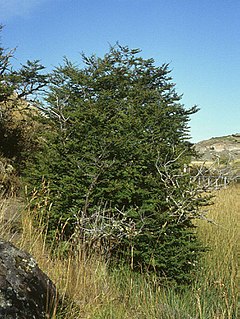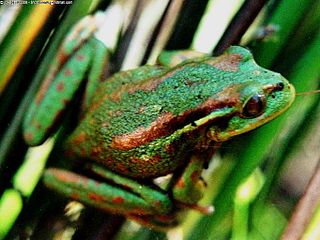
Nothofagus antarctica is a deciduous tree or shrub native to southern Chile and Argentina from about 36°S to Tierra del Fuego, where it grows mainly in the diminishing temperate rainforest.

Nothofagus cunninghamii, the myrtle beech, is an evergreen tree native to Tasmania and Victoria, Australia. It grows mainly in the temperate rainforests, but also grows in alpine areas. It is not related to the Myrtle family. It is often referred to as Tasmanian myrtle within the timber industry. N. cunninghamii was proposed to be renamed Lophozonia cunninghamii in 2013. There has been some controversy over the change in name from Nothofagus to Lophozonia.

Nothofagus dombeyi, Dombey's beech, coigue, coihue or coigüe is a tree species native to southern Chile and the Andean parts of Argentine Patagonia. It is a fast-growing species that can live in a wide range of climatic conditions, and forms dense forests. It is cultivated for its timber, and as an ornamental subject.

Gomortega keule is a tree native to Chile. It is the sole species of the genus Gomortega and, according to the APG IV system of 2016, of the monotypic family Gomortegaceae, assigned to the order Laurales in the clade magnoliids.

Nothofagus betuloides, Magellan's beech or guindo, is a tree native to southern Patagonia.

Nannophryne variegata, known also as the Eden Harbour toad or Patagonian toad, is a species of toad in the family Bufonidae. It is found in southern Argentina and Chile. There is also a record from Peru, but this requires confirmation given its great geographic and ecological isolation. It occurs in Tierra del Fuego south to 53°S, making it the southernmost amphibian in the world, a record shared with Batrachyla antartandica.

Alsodes monticola is a species of frog in the family Alsodidae. It is found in southern Chile and western Santa Cruz Province, Argentina, though its presence in Argentina is disputed. Its habitat preferences are not known, but the region of the type locality has tundra and islands of Nothofagus forest.

Alsodes verrucosus is a species of frog in the family Alsodidae. It is found in the Andes of Chile and Neuquén and Río Negro Provinces, Argentina. These frogs inhabit temperate Nothofagus forest where they occur under logs and near damp areas. Tadpoles develop in cold, deep streams. It is threatened by habitat loss caused by logging.

Hylorina sylvatica is a species of frog in the family Batrachylidae. It is monotypic within the genus Hylorina. It is found in Argentina and Chile. This species is endemic to the austral Nothofagus forests of Chile and Argentina with a narrow distribution along the eastern slopes of the Andes.
Telmatobufo australis is a species of frog in the family Calyptocephalellidae. It is endemic to Chile and occurs in the western and eastern slopes of the Chilean Coast Range in Valdivia and Osorno Provinces. Its natural habitats are fast-flowing streams in temperate Nothofagus forest. It is a rare species threatened by habitat loss that is caused by siltation of streams caused by clear cutting and afforestation with exotic species.

Telmatobufo bullocki is a species of frog in the family Calyptocephalellidae. It is endemic to Chile, and is only known from a few locations in the Cordillera de Nahuelbuta, a part of the Chilean Coast Range. It is extremely rare; extensive fieldwork in 1992–2002 turned up only a single adult. It occurs in fast-flowing streams in temperate Nothofagus forest. The tadpoles are free-swimming and feed on algae growing on submerged rocks. It is threatened by siltation of streams caused by clear-cutting. It occurs within the Nahuelbuta National Park.

Nothofagus alessandrii, the ruil, is a species of plant in the family Nothofagaceae, commonly known as the southern beeches. It is endemic to Chile, occurring chiefly in the Chilean matorral ecoregion. It is threatened by habitat loss. The species is protected within Los Ruiles National Reserve.

Nothofagus alpina, also called rauli or raulí beech is a species of plant in the Nothofagaceae family. A deciduous tree, it grows in Chile and Argentina, it reaches 50 m (160 ft) height and more than 2 meters (6.5 feet) in diameter. Its distribution goes from 35 to 42° South latitude. It is found on the Andes. It tolerates low temperatures and heavy winds. It has a straight and cylindrical trunk with grey bark. N. alpina was proposed to be renamed Lophozonia alpina in 2013.
Nothofagus discoidea is a species of plant in the family Nothofagaceae. It is endemic to New Caledonia.

Nothofagus glauca, commonly known as hualo or roble Maulino, is a species of plant in the family Nothofagaceae. It is a deciduous tree endemic to Chile. It grows from 34° to 37° South latitude. N. glauca was proposed to be renamed Lophozonia glauca in 2013. It is a typical tree of the mediterranean Maulino forest of Central Chile, its current range spanning over 330 km from north to south. The species grow on a variety of soils and is mostly found on gentle to steep slopes.
Nothofagus nuda is a species of plant in the family Nothofagaceae. It is endemic to Papua New Guinea. It is threatened by habitat loss. N. nuda proposed to be renamed Trisyngyne nuda in 2013.
Nothofagus stylosa is a species of plant in the family Nothofagaceae. It is endemic to West Papua (Indonesia). It was proposed to be renamed Trisyngyne stylosa in 2013.
Nothofagus womersleyi is a species of plant in the family Nothofagaceae. It is endemic to West Papua (Indonesia). It was proposed to be renamed Trisyngyne womersleyi in 2013.
Alsodes norae is a species of frog in the family Alsodidae endemic to the Chilean Coast Range in the Valdivia Province, Chile. It is only known from the type series collected from a temperate Nothofagus forest. The threats are not formally known but it may be ongoing deforestation, however, the species may be protected by Oncol Park.

Nothofagus macrocarpa, commonly known as roble de Santiago or Santiago's oak, is a deciduous tree in the Nothofagaceae family that is endemic to the mountains of central Chile. It is sometimes regarded as a subspecies of Nothofagus obliqua. N. macrocarpa proposed to be renamed Lophozonia macrocarpa in 2013.














